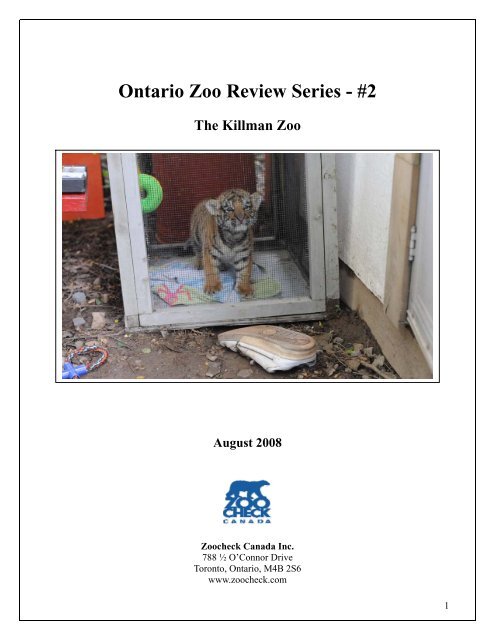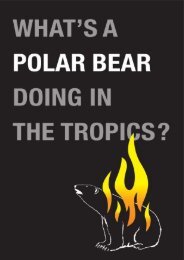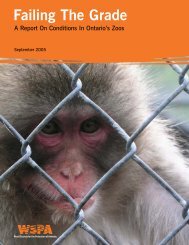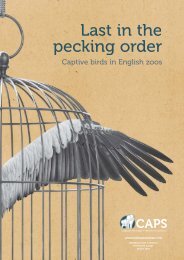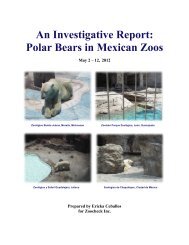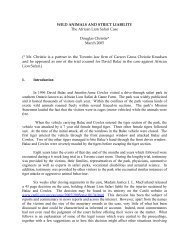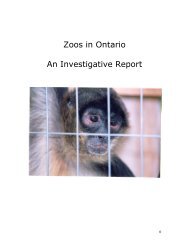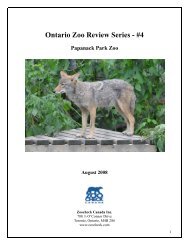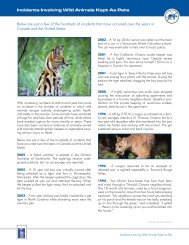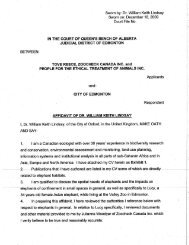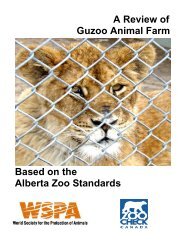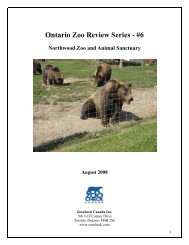The Killman Zoo - Zoocheck Canada
The Killman Zoo - Zoocheck Canada
The Killman Zoo - Zoocheck Canada
Create successful ePaper yourself
Turn your PDF publications into a flip-book with our unique Google optimized e-Paper software.
Ontario <strong>Zoo</strong> Review Series - #2<br />
<strong>The</strong> <strong>Killman</strong> <strong>Zoo</strong><br />
August 2008<br />
<strong>Zoo</strong>check <strong>Canada</strong> Inc.<br />
788 ½ O’Connor Drive<br />
Toronto, Ontario, M4B 2S6<br />
www.zoocheck.com<br />
1
ZOOCHECK CANADA INC.<br />
<strong>Zoo</strong>check <strong>Canada</strong> is a national animal protection charity (#13150 2072 RR 0001) established in 1984 to promote<br />
and protect the interests and wellbeing of wild animals.<br />
Policy<br />
<strong>Zoo</strong>check objects in principle to the keeping, confinement, use, exhibition and performance of wild animals in<br />
captivity as captivity is not in the best interests of those animals 1 . Nor does the exhibition of live wildlife<br />
provide a positive educational experience for the general public. Wild animals removed from their natural<br />
environment and ecological context bear little or no meaningful resemblance to their counterparts in the wild.<br />
Nonetheless, animals are kept in zoos and similar captive situations at present and for these animals,<br />
improvements in the conditions to which they are subjected are urgently needed. <strong>Zoo</strong>check believes the onus<br />
must be on the owners/operators of facilities who choose to keep these animals captive, to provide for them the<br />
best possible care in the circumstances.<br />
<strong>The</strong> Investigation<br />
This report provides an overview of the <strong>Killman</strong> <strong>Zoo</strong> in Caledonia, Ontario on August 4, 2008. It is the<br />
second in a series of investigative reports aimed at providing a snapsnot image of the current status of<br />
captive wild animals in Ontario.<br />
Investigator Profile<br />
In 1978 Else Poulsen received her BSc. in Biology from Brock University and in 1995 her 4 year Diploma in<br />
<strong>Zoo</strong>keeping from the City of Calgary Apprenticeship Programs. She has dealt with variety of animal species, in<br />
her work as a field biologist in Alberta’s energy industry, as a zookeeper at the Calgary <strong>Zoo</strong>, and as a bear<br />
specialist in several other facilities.<br />
She has provided expert assistance and advice about modernizing bear husbandry methods, environmental<br />
enrichment programming and enclosure design issues to zoos, sanctuaries and animal welfare groups around the<br />
world.<br />
Poulsen has more than 40 papers and articles to her name in scientific research and technical journals, textbooks<br />
and other publications. She consults as an animal behavior and captive environment trouble-shooter. She has<br />
also lectured on modern bear care and animal welfare issues to audiences as diverse as university students<br />
studying population genetics to First Nations Band Council members in northern <strong>Canada</strong>.<br />
1 In limited circumstances, exclusively for the purpose of benefiting the individual animal or species, <strong>Zoo</strong>check <strong>Canada</strong><br />
supports the keeping of wild animals in captivity as part of a legitimate rehabilitation and release program, or for nonreleasable<br />
animals that have been retired or rescued, or that are part of a legitimate captive propagation initiative, provided<br />
the animal's physical, psychological and social needs are addressed as the primary concern.<br />
2
THE SITUATION IN ONTARIO<br />
<strong>The</strong>re are currently few rules governing the operation of zoos and other kinds of captive wildlife displays in<br />
Ontario. This lack of regulation has resulted in a proliferation of zoos and zoo-type exhibits in the province.<br />
Ontario has more of these facilities than any other province, including many of the worst in <strong>Canada</strong><br />
Unlike many other jurisdictions, in Ontario, non-indigenous exotic wildlife species are not regulated. Virtually<br />
anyone can acquire exotic wild animals, house them in conditions of their choosing and then open up for public<br />
viewing. <strong>The</strong>re are no laws or regulations requiring the owners or operators of zoos to have expertise or<br />
experience in wild animal care, the financial resources to properly operate their facility or an ability to conduct<br />
their business in a humane and safe manner.<br />
"Specially protected and game wildlife," defined as native wildlife listed in the Fish and Wildlife Conservation<br />
Act, can only be kept and displayed if a license to do so has been obtained from the Ontario Ministry of Natural<br />
Resources (MNR). Three general animal welfare conditions are attached to all licenses, but they are not specific<br />
and are open to interpretation, so enforcement is problematic.<br />
Ontario’s lack of zoo licensing and comprehensive wildlife in captivity standards has resulted in a large number<br />
of zoos and wildlife menageries operating at a standard of their own choosing. <strong>The</strong>re is nothing in place that<br />
specifically addresses the many issues associated with the capture, breeding, keeping and display of wild animals<br />
in zoos and zoo-type exhibits.<br />
<strong>The</strong> unfettered proliferation of wild animal displays in Ontario has been recognized as a problem for<br />
approximately 30 years. Numerous measures to deal with this issue have been initiated, but none have been fully<br />
supported by government, so the captive wildlife industry remains essentially unmonitored and uncontrolled to<br />
this day.<br />
<strong>The</strong> Government of Ontario has the ability to create a regulatory regime for all wildlife in captivity that is<br />
consistent with other jurisdictions, comprehensive, fair to license holders and respectful of the many individual<br />
animals whose lives are directly affected by it. In addition to numerous workable and adaptable models being<br />
available in other jurisdictions, in 2001, the MNR published its own set of standards for zoos.<br />
Comprehensive Licensing and Regulation is Required<br />
<strong>The</strong> Ontario government should implement and administer a comprehensive zoo and wildlife in captivity<br />
regulatory program that requires anyone holding native and/or exotic wild animals in captivity to obtain a license<br />
and to satisfy a series of conditions as to their knowledge, experience, financial abilities, wild animal housing<br />
and management practices, safety procedures and other relevant issues. Licenses should be issued annually and<br />
only after an inspection of the premises to be licensed is conducted. <strong>The</strong> regulatory program should include the<br />
ability to conduct special inspections, penalties for non-compliance and provisions for license revocation.<br />
Bill 50, An Act to amend the Ontario Society for the Prevention of Cruelty to Animals Act<br />
In 2008, the Ontario government introduced Bill 50, An Act to amend the Ontario Society for the Prevention of<br />
Cruelty to Animals Act. During the buildup to the introduction of the Act, government officials and elected<br />
representatives said the Act would deal with a variety of animal welfare issues, including roadside zoos.<br />
Bill 50 would:<br />
• Make it a provincial offence to abuse any animal. Ontario is the only province where it is not an offence<br />
to abuse most animals. It is only an offence to abuse cats and dogs in commercial breeding operations.<br />
• Establish penalties including a lifetime ban on owning animals.<br />
3
• Allow the Ontario SPCA to inspect roadside zoos and other facilities that keep animals. Currently,<br />
anyone can refuse to show the Ontario SPCA their animals.<br />
• Establish animal care standards and make failing to comply with these an offence.<br />
While Bill 50 contains a number of very positive features and will significantly improve the existing Ontario<br />
SPCA Act, it will not address most of the problems that have been identified in zoos and zoo-type exhibits<br />
across the province.<br />
Even though the Ontario government has repeatedly indicated its intent to deal with wildlife in captivity issues<br />
through Bill 50, there are currently no standards or regulations being proposed at this time. If standards of some<br />
kind are developed in future, they will not contain up front licensing of zoos and zoo-type exhibits that screen<br />
persons wanting to own wild animals or open public displays. Standards promulgated under Bill 50 will be<br />
enforced retroactively after animals have been acquired or a zoo or wildlife display opened.<br />
If, as the Government of Ontario has stated, Ontario is to move from "worst to first" in animal protection, then<br />
Bill 50 must include comprehensive regulations for zoos. With the weakest zoo regulations in the country,<br />
Ontario is the only province that does not require zoos and zoo-type facilities to meet specific public safety<br />
requirements and does not require residents to obtain a license to keep exotic wild animals.<br />
<strong>The</strong> lack of appropriate laws and regulations, and the difficulties inherent in enforcing the existing relatively<br />
minor welfare provisions attached to licenses issued under the Fish and Wildlife Conservation Act, mean that<br />
Ontario’s zoos and wildlife exhibits go more or less unchecked. This has left a need for independent animal<br />
welfare agencies, such as <strong>Zoo</strong>check <strong>Canada</strong> and the World Society for the Protection of Animals (WSPA), to<br />
proactively and comprehensively monitor and evaluate these facilities for concerns of human health and safety<br />
and animal welfare.<br />
4
COMMENTARY – <strong>The</strong> <strong>Killman</strong> <strong>Zoo</strong><br />
General<br />
<strong>The</strong> <strong>Killman</strong> <strong>Zoo</strong> was inspected by Else Poulsen in 2006. Some changes have been made since that time, but<br />
most of them do not substantially improve animal welfare. <strong>The</strong>y include:<br />
1. <strong>The</strong> zoo has now changed ownership from the elder <strong>Killman</strong> to his son Mark <strong>Killman</strong> and his wife Rhonda.<br />
<strong>The</strong> zoo now advertises itself as one of the largest collection of exotic cats in Ontario.<br />
2. <strong>The</strong> public pathway has been altered so that it is no longer a loop but instead is a dead-end where the public<br />
have to turn around and return in the same direction that they came from. This poses a serious safety concern for<br />
the public who could be confused or trapped during an animal escape or fire as they are confined by cages,<br />
fencing and forest.<br />
3. I estimate there are at least 90% fewer goats and other hoof stock, domesticated rabbits, pheasants and<br />
waterfowl than in 2006. This could be a cost issue as the zoo lost income during the land claim stand off between<br />
the governments and Six Nations beginning in 2006 (source: Mark <strong>Killman</strong> 2006). To generate additional<br />
income the family is still breeding and selling Vietnamese pot-bellied pigs, ferrets and doves [photos 2184,<br />
2196], selling cans of peanuts to feed to the animals and they have placed coin operated gumball machines<br />
throughout the facility.<br />
Husbandry and Animal Welfare<br />
Although there are now fewer animals in the menagerie there does not seem to have been an improvement in the<br />
overall welfare of the animals. Cages are still "homemade," constructed primarily of wooden planks and chainlink<br />
fence or wire mesh. <strong>The</strong>y are still generally box-like in shape regardless of the species they contain. <strong>The</strong><br />
facility is entirely engulfed in forest and, due to the rains this summer, is particularly lush, thick and inviting, yet<br />
none of this vegetation is available to the animals – with one exception. <strong>The</strong> lions and tigers time-share a large<br />
poorly fenced-in pond choked with duck weed. It’s an all natural exhibit that can only be used part time by<br />
several of the animals.<br />
Cages do not seem to have fencing buried into the ground around their perimeters to prevent escapes by digging<br />
and the inversely angled tops are of flimsy construction and only supported by 2”x 4” wooden planks.<br />
<strong>The</strong> facility does have satisfactory public stand-off barriers and signage (located throughout the zoo) displaying<br />
a hand missing several digits indicating that visitors could lose a finger if they try to reach into the animal cages.<br />
It seems that the owners are attempting to appeal to family visitors. <strong>The</strong>y have newly painted dens, platforms and<br />
other surfaces in bright, child-friendly colors. Painted, oiled and sealed surfaces can be toxic to animals if they<br />
gnaw on the wooden surfaces. A male olive baboon was observed to be chewing on a wooden post and<br />
swallowing it as there was nothing else to interact with in his cage. <strong>The</strong> owners are continuing to name young<br />
animals after cartoon characters, such as the two lion cubs born in early spring 2008 named Lois Lane [photo<br />
2163] and Lex Luther [photo 2156]. Older animals, such as a male and female lemur, are named Dracula and<br />
Buffy the Vampire Slayer [photo 2159]. While these names may be somewhat memorable, they may also present<br />
a false image of these animals to zoo visitors.<br />
Most cages are completely barren of species-specific cage furnishings, and offer only wooden resting platforms<br />
and, often inappropriately sized, decaying wooden dens. Most of the animals do not have adequate pools for<br />
bathing.<br />
For the most part, the animals appeared lethargic, many were obese and lacked good muscle tone. At least six<br />
5
cats were observed to be actively engaged in stereotypies, pacing for the duration of the inspection. Pacing<br />
pathways inside the cages are evidence of problematic pacing issues.<br />
One particularly concerning aspect of the zoo was the treatment of the lion and tiger cubs. At the entrance to the<br />
zoo between the outdoor garage sale-like ‘gift shop’ tables and the ticket shack was a tiny cage (.6m x’.6m x<br />
.91m) with a tiger cub only months old. This cub who was being hand-raised appeared deeply distressed and was<br />
observed clawing and screaming, but no staff responded, although keeper staff, gate staff and the owner was<br />
nearby. Two lion cubs (possibly from the same litter), also only months old, were housed in separate enclosures<br />
completely devoid of any stimulation. Both male and female were observed pacing.<br />
A male and female cougar were housed together, outside of breeding season, and seemed extremely agitated,<br />
making verbal threats and moving cautiously around each other. Staff walked by without stopping or noticing<br />
during the cat’s lengthy disagreement, which easily could have led to a physical fight.<br />
Gina, a female American black bear that was observed in 2006, still lives alone in a barren enclosure, standing<br />
up on command for peanuts. Her enclosure fence is thin gauge wire, low in height and does not seem to be<br />
buried into the ground around the perimeter. Suitably motivated, there is little reason to believe Gina could not<br />
escape.<br />
Public Safety<br />
Inappropriately thin gauge wire mesh in the large carnivore cages throughout the facility is problematic. None of<br />
these cages are entirely safe from animal escape.<br />
Despite the reduction in animal numbers, some can still be touched by visitors, but there do not seem to be any<br />
hand-wash stations in the facility.<br />
<strong>The</strong> wooden bridge constructed for visitors to cross a creek is in disrepair and fencing along the public pathway<br />
is often broken, tangled and a potential hazard to young children.<br />
Public Education<br />
Signage providing accurate natural history, biological and conservation information is problematic. A mix of old,<br />
often decaying hand-made signs and newly posted information sheets written in small lettering and<br />
overwhelmingly lengthy making it unappealing to adults who have children in tow and need to move on. <strong>The</strong><br />
height and style of these signs are not child friendly and are thus ignored by children.<br />
Summary<br />
Key problems at <strong>The</strong> <strong>Killman</strong> <strong>Zoo</strong> include:<br />
• Undersized, barren cages that provide substandard, sensory deprived environments for the animals they<br />
contain.<br />
• Under-stimulated, obese animals.<br />
• Lack of sunshine. <strong>The</strong> majority of the cages are in a heavily forested area where the tree canopy filters a<br />
good portion of direct, natural sunlight. <strong>The</strong> shady areas seem to harbour large numbers of flies and<br />
mosquitoes.<br />
• Unnecessary breeding of native, exotic and domesticated animal species.<br />
• Grossly inappropriate husbandry routines for lion and tiger cubs.<br />
6
• <strong>The</strong> goats beg for food and were observed licking the fingers of numerous visitors. <strong>The</strong>re are no handwash<br />
stations for visitors to use as a safeguard against zoonoses (disease transfer from animals).<br />
• Potentially unsafe conditions for human visitors and animals, including rusty, rotting cage materials and<br />
lack of appropriate exit signage.<br />
This facility is deficient in many respects. <strong>The</strong> zoo's housing and management practices reveal only a<br />
rudimentary understanding of the needs and actual welfare status of the animals. <strong>The</strong> problems are substantial<br />
and the quality of life experienced by the animals is questionable, at best. This facility should be closed and the<br />
live collection dispersed to more appropriate accommodation elsewhere.<br />
NOTE: On the front page of its website is the following statement, “<strong>Killman</strong> <strong>Zoo</strong> is private property. It is not a<br />
forum for protest. <strong>The</strong> proprietors reserve the right to refuse entry to any person and, in particular, to any<br />
member or affiliate of WSPA, PETA, <strong>Zoo</strong> Check and other similar animal rights organizations. Members or<br />
affiliates of those organizations found on these premises without express written permission from <strong>The</strong> <strong>Killman</strong><br />
<strong>Zoo</strong> will be charged with trespassing pursuant to the Trespass to Property Act of Ontario.” While it is the right of<br />
the zoo owner to post whatever notice he wants, one has to wonder why this zoo is so averse to criticism. <strong>The</strong><br />
notice must certainly also be a red flag to people who wanted to visit but are sensitive to animal welfare issues<br />
and so choose not to.<br />
7
Animal enclosures must be equipped with furnishings and enrichment that keep the animals<br />
occupied. This baboon should not have to seek stimulation be reaching through the barrier.<br />
This lion cub lives on a hard floor surface in a barren<br />
cage. Lions are the most social of cats and should be<br />
kept in their proper social grouping. Since they already<br />
overpopulated in captivity, they should not bred.<br />
8
Pacing can be a sign of frustration, deprivation and boredom. This lion cub is held<br />
in a barren, hard floored cage with nothing to do.<br />
This tiger cub is distressed by being confined in such a tiny, inappropriate cage away from its mother.<br />
Most captive tigers are hybrids and they are already severely overpopulated in captivity.<br />
9
Cute names don’t mask the barren, impoverished living conditions of the animals.<br />
<strong>The</strong> <strong>Killman</strong> <strong>Zoo</strong> uses a “cookie-cutter” approach to animal accommodation.<br />
Most animals, regardless of species, live in wooden framed, box-like cages, even<br />
if they have very different biological and behavioural needs.<br />
10
Animals that have nothing to do become obese and spend a<br />
great deal of their time sitting, lying or sleeping.<br />
This simplistic environment with its small climbing apparatus will not keep<br />
this bear occupied and engaged.<br />
11
All animals should be provided with multiple privacy areas that allow them<br />
to remove themselves from public view or the view of their cagemates.<br />
<strong>The</strong> hard floor surface, lack of furnishings, absence of privacy and<br />
small space make this cage particularly deficient.<br />
12
This barren cage leaves this cat with nothing to do but sit.<br />
New paint on the den box, platform and waterbowl container do nothing to<br />
improve the welfare of the animals.<br />
13
CONCLUSIONS & RECOMMENDATIONS<br />
This series of investigative reports highlight animal welfare and human safety concerns in zoos and<br />
wildlife displays across the province.<br />
Key problems identified in Ontario zoos in 2008 include:<br />
1. Poor animal health and welfare;<br />
2. Undersized, badly constructed, poorly designed cages and enclosures;<br />
3. Inappropriate substrates (floor surfaces);<br />
4. Lack of adequate shelter and privacy;<br />
5. Lack of stimulation (e.g., furniture, objects, other enrichment);<br />
6. Lack of nutritive food and potable water;<br />
7. Inadequate safety and security measures.<br />
Many of these problems have been identified in previous reports by various parties in past years.<br />
Recommendation<br />
Bill 50, An Act to amend the Ontario Society for the Prevention of Cruelty to Animals Act is currently<br />
being considered by the Government of Ontario. It contains a number of very positive features and will<br />
significantly improve the existing Ontario SPCA Act. However, there are currently no standards or<br />
regulations being proposed at this time within Bill 50 or in any other provincial legislation that will<br />
properly address issues associated with the keeping of wildlife in captivity. Ontario has the ability to<br />
create a regulatory regime within Bill 50 and in other legislation that is both comprehensive and<br />
workable but, so far, has chosen not to do so.<br />
In order to properly handle the various animal welfare and human safety concerns inherent in the<br />
operation of zoos and wildlife displays, a comprehensive regulatory regime is required. Regulations<br />
must require anyone holding native and/or exotic wild animals in captivity to obtain a license and to<br />
satisfy a series of conditions as to their knowledge, experience, financial abilities, wild animal housing<br />
and management practices, safety procedures and other relevant issues. Annual licenses should only be<br />
issued after an inspection of the premises that is to be licensed is conducted. <strong>The</strong> regulatory program<br />
should include the ability to conduct special inspections, penalties for non-compliance and provisions<br />
for license revocation.<br />
If, as the Government of Ontario has stated, Ontario’s animal protection laws are to be brought from<br />
“worst to first,” then Bill 50, An Act to amend the Ontario Society for the Prevention of Cruelty to<br />
Animals Act must include comprehensive zoo regulations that adequately and proactively address<br />
animal welfare and human safety concerns in Ontario zoos and wildlife displays.<br />
14


